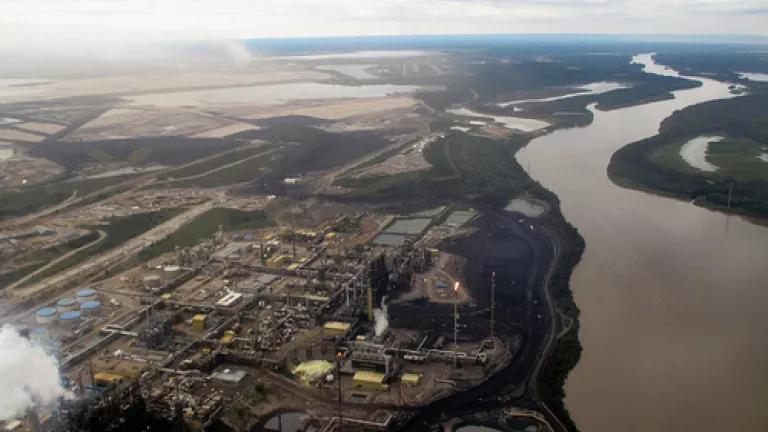
As the U.S. government winds up its review deciding whether to issue a permit for the proposed Keystone XL tar sands pipeline, it should pay attention to new policies just released in Alberta addressing the tar sands industry's hungry thirst for the province's water resources. Recently, Alberta's premier Jim Prentice traveled to Washington, D.C. to lobby for the proposed Keystone XL tar sands pipeline and defend Alberta's environmental record on oil development. In fact, he called Alberta's management of the tar sands "world class." But a watershed plan just released by the Government of Alberta meant to protect the Athabasca River from excessive tar sands water diversions exempts two of the largest tar sands companies from full compliance, demonstrating that in Alberta the interests of the oil industry are strongly favored over environmental protection. Furthermore, the watershed plan is voluntary relying on industry reporting instead of legally enforceable mechanisms. This newly-released plan is unfortunately another example of the Governments of Alberta and Canada failing to measure up to claims that they are pursuing exemplary management of tar sands development.
Source: Pembina Institute, Oilsands Operation Next to Athabasca River
Every day millions of gallons of water are diverted from the lower Athabasca River for massive tar sands mining operations. Tar sands mines use 2.4 barrels of fresh water for every barrel of tar sands (or diluted bitumen) produced. Water licenses issued by the Government of Alberta have almost doubled since 2000 as more and more tar sands mines come online. Within the next decade, total water diversions from the river will eventually grow to 133 billion gallons per year.
The problem is exacerbated during the river's seasonal low flows, which are stressful for fish and river ecosystems. During low-flow periods, habitat is sharply reduced, water quality may worsen, and food sources may decrease. To maintain ecosystem health, a certain amount of water must be left in the rivers during these low-flow periods. And this means tar sands companies diverting massive volumes of water from the river must cease water diversions when there is already little water left in the river.
The Athabasca River is the province's longest and only free-flowing river and one of the longest free-flowing rivers in North America. Over 10 years ago, as tar sands development grew, so did attention to the growing problem of companies' use of the river's water. Every river depends on at least some water to flow through it, and the Athabasca River is no exception. The river supplies the largest direct inflow of water to the Peace-Athabasca Delta - one of the world's largest freshwater deltas, a wetland of international significance, and among the most important waterfowl nesting and staging areas in North America. The Delta is home to dozens of mammals including moose, lynx, and wolves and the world's largest population of free-roaming bison.
Over 99 percent of the water diverted from the Athabasca River used to process the heavy tar sands is never returned because it is too contaminated. The remaining toxic wastewater is then stored in a growing number of massive lakes that now cover an area the size of Washington, D.C. My colleague Jennifer Skene is commenting on how the Government of Alberta's new policy attempting to address the toxic tailings issue also fails to demonstrate environmental leadership.
The history of efforts to develop this recently released watershed plan goes back over 10 years to a government report that observed that multiple tar sands mining operations were placing the Athabasca River under pressure. At the time, they directed the federal and provincial governments to establish a water plan to protect the river flows. Soon after, the Government of Alberta issued a preliminary "Phase 1" plan, which was a voluntary industry agreement and failed to cut off of diversions during low winter flows.
This most recent plan, called the Athabasca Region Surface Water Quantity Management Framework for the Lower Athabasca River, that was just released by the Government of Alberta replaced an earlier framework adopted in 2007 (called the Water Management Framework: Instream Flow Needs and Water Management System for the Lower Athabasca River).
The major debate in developing this most recent plan was whether the Government of Alberta would finally adopt an Ecosystem Base Flow or EBF. An EBF essentially establishes cut-offs prohibiting diversions when rivers levels fall below a certain level in order to protect the ecosystem. In other words, tar sands operators would be required to cease their diversions when the river was most vulnerable during its low-flow periods. The Canadian Science Advisory Secretariat, an independent body of experts, convened to investigate this issue, and issued a report to the Governments of Canada and Alberta in September, 2010, clearly recommending an Ecosystems Base Flow for the Lower Athabasca River.
But the plan just released from the Government of Alberta failed to establish an enforceable plan with an EBF. And the plan enables two companies with large water diversion licenses to continue diverting water even when the river has little water and, from an ecosystem perspective, is vulnerable.
That's not to say there isn't anything good about the water plan. It establishes a system for weekly limits depending on the rivers' flow and seasonable variability. And it is certainly good news that water licenses for new tar sands mining operations are required to cut off diversions when river flows are low. But the Government of Alberta declined to adopt the strong and central recommendation from First Nations and scientists to include an EBF. This sends the wrong signal, casting doubt on the Government of Alberta's commitment to environmental leadership.
